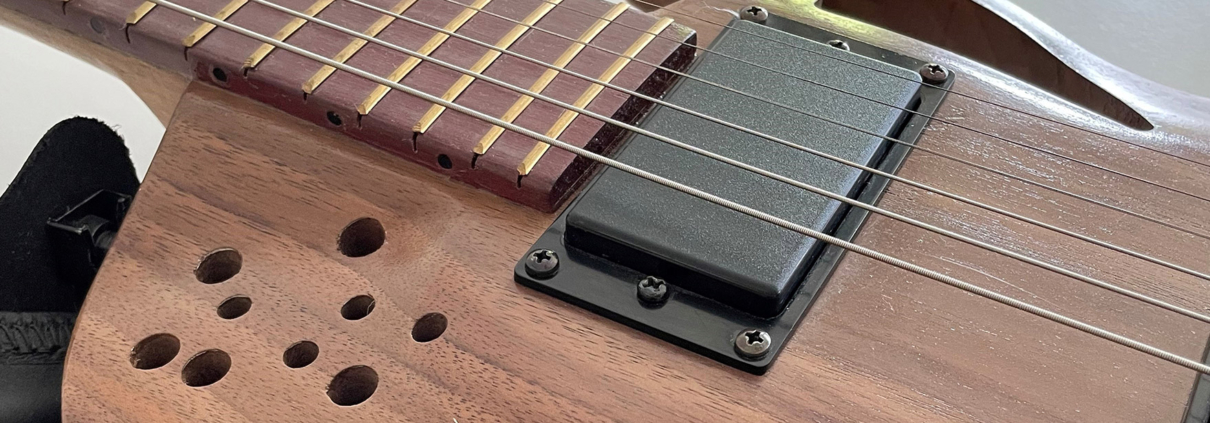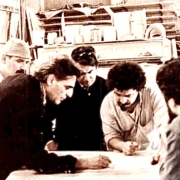How to build a guitar? Let’s ask Massimo Carturan, brilliant musician and dear friend of Devoto
How to build a guitar? And an electric guitar? What kind of wood is it advisable to use to make a soundboard? After reading our article “Devoto Design’s handcrafted electric guitar: hear the story!” a lot of people told us they wanted to know more about this interesting project. That’s why we decided to ask the one who came up with the idea and developed the project: our friend and brilliant musician Massimo Carturan, a dear friend of Devoto Design.
HOW TO BUILD A GUITAR?
WHEN DID IT ALL START? Well, let’s see.. When I was 22 I found the neck of a guitar on the beach. I wondered how it had ended up there and how come it was broken. With the support of my friend Claudio Devoto, I decided I wanted to build it up again, putting together some ideas that I had already had in my mind. Then, though, because of our university tasks and a bit of distraction too, we dropped the project and never put it into action.. all that was left was a drawing and the dream of building a guitar from scratch.
So Massimo, tell us where and when your passion for lutherie was born and how you and Claudio managed to conceive and build these beautiful guitars..
Well, defining what I do “lutherie” is a bit of an overstatement, I think.. Sure it is a hobby I have been having for a long time. So far I have built 15 guitars and I am about to complete another one in the next few days.
What I did is I simply joined the engineering skills I got from my university studies with the interesting and innovating research of specialized acoustic engineers such as eng. Ciurlo (designer at EKO) and scientists like Dr. Kasha. He, together with luthier Schneider, has built an insteresting kind of guitar that I often take as a reference in my projects. I took cues from their ideas and matched them to some intuitions of mine for what concerns both the structural and harmonic design.
And how did you meet Claudio?
Well, it is hard to say exactly when, to be honest. We’ve known each other for 50 years! I guess I met him at some friends’ house.. I remember he used to live in a farmhouse he was renting and he had just started his carpentry lab, using the barn as his workshop. He is a dear friend I care a lot about. I think highly of his work, he is a great man..
We so want to know what he told you when you suggested you build a guitar together.. what did he say?
It was a lot of years after I had found that neck of the guitar on the beach. As it often happens with him, as soon as I talked to him he got extremely excited and offered me his machines and his knowledge. Then, some years later – I was 40 I think – I told him I wanted to start building guitars again and he – with the same enthusiasm – gave me a pair of beautiful soundboards he’d made. It’s with those two soundboards that my luthery hobby started some years later: I fixed the soundboard of a guitar that belonged to a priest. But that’s another story..
How to build an acoustic guitar?
First of all, as far as I’m concerned, it all starts with a calculation sheet where I insert the costruction logics of a project published by eng. Ciurlo that I customized according to my experience and needs. Then I transfer the data into a CAD program that helps me design all the different parts of the guitar. After that I choose the wood that I usually buy at Rivolta. It is often Claudio that provides me with some of his production wood “scraps”, because if we compare the size of the parts of a guitar to the massive size of the elements that Devoto usually works, we’re talking about little but precious scraps..
And then you start the real production…
That’s right. First thing I cut the soundboard and the back of the guitar. According to the project, then, I proceed with the bracing, which is the main supporting structure of both the soundboard and the back.
We know that your soundboards have a particular design. What inspired you?
The bracing and the design of my soundboards are particular because they are inspired by Dr. Kasha’s ideas who believes that guitars are no symmetrical instruments. And I totally agree with him. So the soundhole of my guitars is different from other guitars: it is not in the middle of the body but up right. This “gives” more wood to the strings according to the frequency they produce and the typical scheme:
- Low sounds = long fibres
- High sounds = short fibres
At this point I do as most luthiers do:
- I carve and smooth the neck and the fretboard
- I insert the soundboard into the neck
- I add the kerfings
- I glue the bow limbs to the board (after having hot-bent them)
- I add more support kerfings on the back of the guitar
- I add the back
- I glue the bridge where the strings are placed
Then it’s time for the final finishes
Yes, like edges and decorations. But the last stage is the painting and at this point I always rely on Claudio’s precious advice. I wish to clarify that I don’t use moulds to craft my guitars as many people do. This is because the guitars I build are unique and have different size and shape according to the new ideas I want to test.
Massimo, many of us are fascinated by the electric guitars you built: how different and how hard is it to build one from scratch?
Well, then you’ll be surprised to know that it is actually easier to build an electric guitar than an acoustic one. At least as far as wood is concerned…
And that’s because the sound doesn’t depend only on wood, right?
Yes, the quality of the sound depends largely on the electric part that catches the vibration of the strings, the pickups. This said, I like testing new ideas and looking for new solutions for what concerns the wood part. For the electric and electronic components there is little to do – I only buy them, install them and wire them up.
Can you please tell us more?
Well, I’ll give you an example: to build an electric guitar I once obtained both the body and the neck by carving an olive tree board without any joints. The guitar is pretty heavy as you can imagine but it looks so good…
As far as wood is concerned, did you know the main types in use?
No, not at all. I had to read a lot about it. I studied the different types of wood and their acoustic features. That’s how I found out that Italy is a country of luthiers because we have the best preserved fir woods in the world. Did you know that fir wood is the harmonic wood par excellence and it is used to build the soundboard of all the string instruments and good part of the plucked instruments like guitars? Thanks to Claudio’s advice I learned lots of things and improved my technique. I’m sure without his help I wouldn’t have had the chance to turn my dream into reality..
Are you happy with the results both from the acoustic and aesthetical point of view?
Absolutely. The guitars I’ve built so far sound exactly like I wanted them to sound. I can proudly say that some professional musicians I know appreciate them and like them. I admit they have a peculiar sound because they tend to enhance the lows and highs.
What are your plans for the future?
Well, I won’t stop trying new solutions and new sounds… I am currently building a classical guitar – this time I decided to design a symmetrical guitar. I can’t wait to complete it and hear its sound… than I would like to build an acoustic guitar by using only one type of local wood, probably chestnut, as Claudio suggested. Wait, then I want to build an electric guitar similar to the Fender Telecaster for my son and a bass guitar… I mean, I’ve got lots of idea I want to explore!
Thank you Massimo for answering our questions!
Thank you, it was a pleasure!
“How to build an acoustic guitar? First of all, as far as I’m concerned, it all starts with a calculation sheet…”
Do you want to know more about building a guitar?
Read “Devoto Design’s handcrafted electric guitar: hear the story!” the first article about this topic


 devoto design
devoto design 
 paolo fusco
paolo fusco
Leave a Reply
Want to join the discussion?Feel free to contribute!